Generation of Ultrashort Optical Pulses in the Deep-Ultraviolet Region Based on Four-Wave Raman Mixing
Abstract
:1. Introduction
2. Experimental Section
3. Results and Discussion
3.1. Generation of Raman Sidebands
3.2. FROG Trace
3.3. Relative Phases among Raman Sidebands
3.4. Phase Control of the Raman Sidebands
4. Conclusions
Author Contributions
Acknowledgments
Conflicts of Interest
References
- Imasaka, T. Gas chromatography/multiphoton ionization/time-of-flight mass spectrometry using a femtosecond laser. Anal. Bioanal. Chem. 2013, 405, 6907–6912. [Google Scholar] [CrossRef] [PubMed]
- Kouno, H.; Imasaka, T. The efficiencies of resonant and nonresonant multiphoton ionization in the femtosecond region. Analyst 2016, 141, 5274–5280. [Google Scholar] [CrossRef] [PubMed]
- Durfee, C.G.; Backus, S.; Kapteyn, H.C.; Murnane, M.M. Intense 8-fs pulse generation in the deep ultraviolet. Opt. Lett. 1999, 24, 697–699. [Google Scholar] [CrossRef] [PubMed]
- Trushin, S.A.; Kosma, K.; Fuß, W.; Schmid, W.E. Sub-10-fs supercontinuum radiation generated by filamentation of few-cycle 800 nm pulses in argon. Opt. Lett. 2007, 32, 2432–2434. [Google Scholar] [CrossRef] [PubMed]
- Ghotbi, M.; Trabs, P.; Beutler, M. Generation of high-energy, sub-20-fs pulses in the deep ultraviolet by using spectral broadening during filamentation in argon. Opt. Lett. 2011, 36, 463–465. [Google Scholar] [CrossRef] [PubMed]
- Adachi, S.; Suzuki, T. Self-compression of femtosecond deep-ultraviolet pulses by filamentation in krypton. Opt. Lett. 2017, 42, 1883–1886. [Google Scholar] [CrossRef] [PubMed]
- Noack, F.; Steinkellner, O.; Tzankov, P.; Ritze, H.-H.; Herrmann, J.; Kida, Y. Generation of sub-30 fs ultraviolet pulses by Raman induced phase modulation in nitrogen. Opt. Express 2005, 13, 2467–2474. [Google Scholar] [CrossRef] [PubMed]
- Fuji, T.; Horio, T.; Suzuki, T. Generation of 12 fs deep-ultraviolet pulses by four-wave mixing through filamentation in neon gas. Opt. Lett. 2007, 32, 2481–2483. [Google Scholar] [CrossRef] [PubMed]
- Kida, Y.; Liu, J.; Teramoto, T.; Kobayashi, T. Sub-10 fs deep-ultraviolet pulses generated by chirped-pulse four-wave mixing. Opt. Lett. 2010, 35, 1807–1809. [Google Scholar] [CrossRef] [PubMed]
- Beutler, M.; Ghotbi, M.; Noack, F. Generation of intense sub-20-fs vacuum ultraviolet pulses compressed by material dispersion. Opt. Lett. 2011, 36, 3726–3728. [Google Scholar] [CrossRef] [PubMed]
- Graf, U.; Fieß, M.; Schultze, M.; Kienberger, R.; Krausz, F.; Goulielmakis, E. Intense few-cycle light pulses in the deep ultraviolet. Opt. Express 2008, 16, 18956–18963. [Google Scholar] [CrossRef] [PubMed]
- Reiter, F.; Graf, U.; Schultze, M.; Schweinberger, W.; Schröder, H.; Karpowicz, N.; Azzeer, A.M.; Kienberger, R.; Krausz, F.; Goulielmakis, E. Generation of sub-3 fs pulses in the deep ultraviolet. Opt. Lett. 2010, 35, 2248–2250. [Google Scholar] [CrossRef] [PubMed]
- Belli, F.; Abdolvand, A.; Chang, W.; Travers, J.C.; Russell, P.S.J. Vacuum-ultraviolet to infrared supercontinuum in hydrogen-filled photonic crystal fiber. Optica 2015, 2, 292–300. [Google Scholar] [CrossRef]
- Sollapur, R.; Kartashov, D.; Zürch, M.; Hoffmann, A.; Grigorova, T.; Sauer, G.; Hartung, A.; Schwuchow, A.; Bierlich, J.; Kobelke, J.; et al. Resonance-enhanced multi-octave supercontinuum generation in antiresonant hollow-core fibers. Light Sci. Appl. 2017, 6, e17124. [Google Scholar] [CrossRef]
- Imasaka, T.; Kawasaki, S.; Ishibashi, N. Generation of more than 40 laser emission lines from the ultraviolet to the visible regions by two-color stimulated Raman effect. Appl. Phys. B 1989, 49, 389–392. [Google Scholar] [CrossRef]
- Shverdin, M.; Walker, D.; Yavuz, D.; Yin, G.; Harris, S. Generation of a single-cycle optical pulse. Phys. Rev. Lett. 2005, 94, 033904. [Google Scholar] [CrossRef] [PubMed]
- Chan, H.-S.; Hsieh, Z.-M.; Liang, W.-H.; Kung, A.H.; Lee, C.-K.; Lai, C.-J.; Pan, R.-P.; Peng, L.-H. Synthesis and measurement of ultrafast waveforms from five discrete optical harmonics. Science 2011, 331, 1165–1168. [Google Scholar] [CrossRef] [PubMed]
- Kida, Y.; Sakamoto, K.; Imasaka, T. High-energy multicolor femtosecond pulses in the deep-ultraviolet generated through four-wave mixing induced by three-color pulses. Appl. Phys. B 2016, 122, 214. [Google Scholar] [CrossRef]
- Vu, D.; Nguyen, T.N.; Imasaka, T. Generation of a femtosecond vacuum ultraviolet optical pulse by four-wave Raman mixing. Opt. Laser Technol. 2017, 88, 184–187. [Google Scholar] [CrossRef]
- Nighan, W.L., Jr.; Gong, T.; Liou, L.; Fauchet, P.M. Self-diffraction: A new method for characterization of ultrashort pulses. Opt. Commun. 1989, 69, 339–344. [Google Scholar] [CrossRef]
- Kane, D.J.; Trebino, R. Characterization of arbitrary femtosecond pulses using frequency-resolved optical gating. IEEE J. Quantum Electron. 1993, 29, 571–579. [Google Scholar] [CrossRef]
- Trebino, R. Frequency-Resolved Optical Gating: The Measurement of Ultrashort Laser Pulses; Kluwer Academic Publishers: Dordrecht, The Netherlands, 2002. [Google Scholar]
- Aussenegg, F.R.; Lippitsch, M.E.; Brandmüller, J.; Nitsch, W. Collinear and noncollinear emission of anti-stokes and second order stokes Raman radiation. Opt. Commun. 1981, 37, 59–66. [Google Scholar] [CrossRef]
- Nagy, T.; Simon, P. Single-shot TG FROG for the characterization of ultrashort DUV pulses. Opt. Express 2009, 17, 8144–8151. [Google Scholar] [CrossRef] [PubMed]
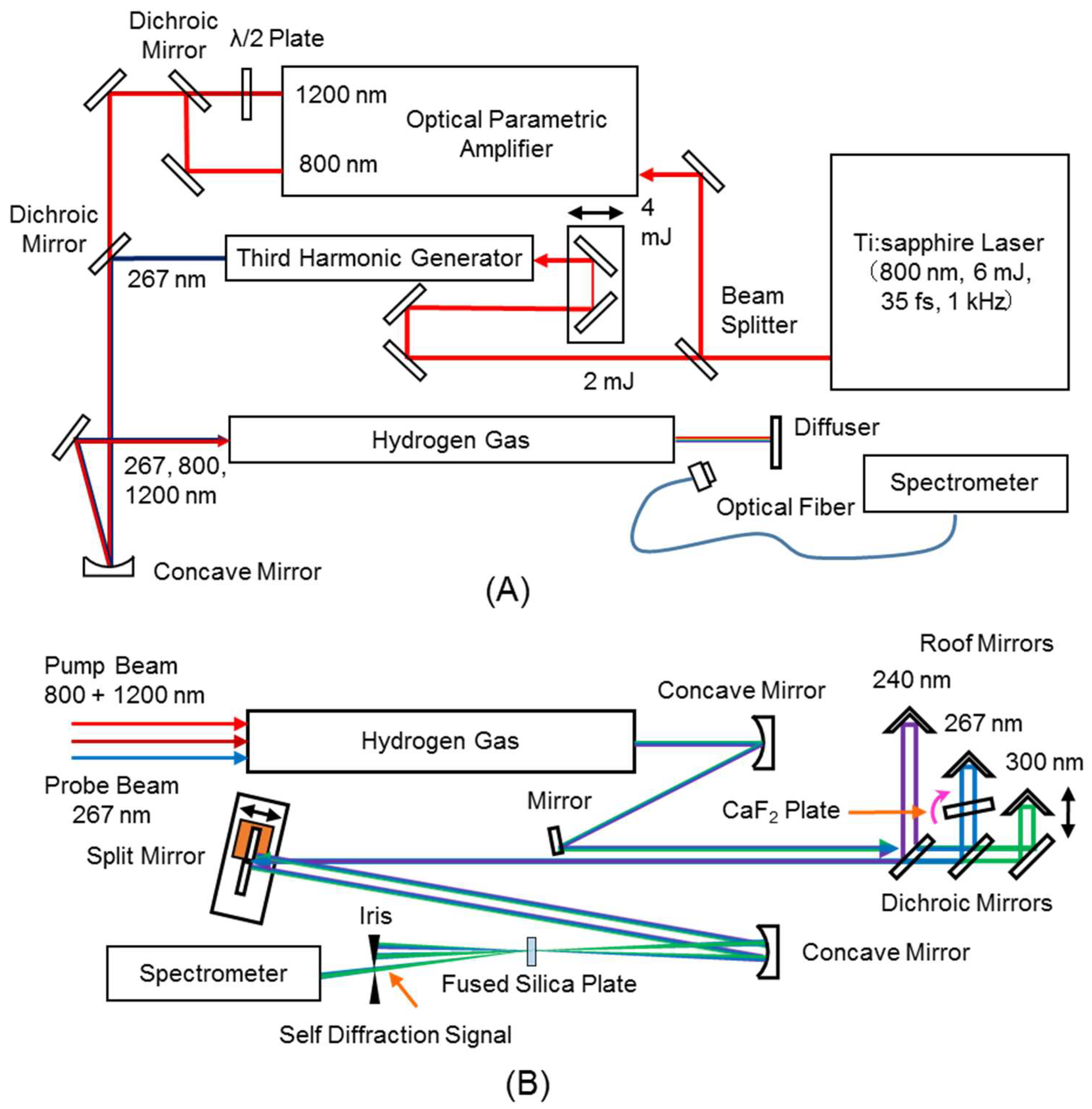
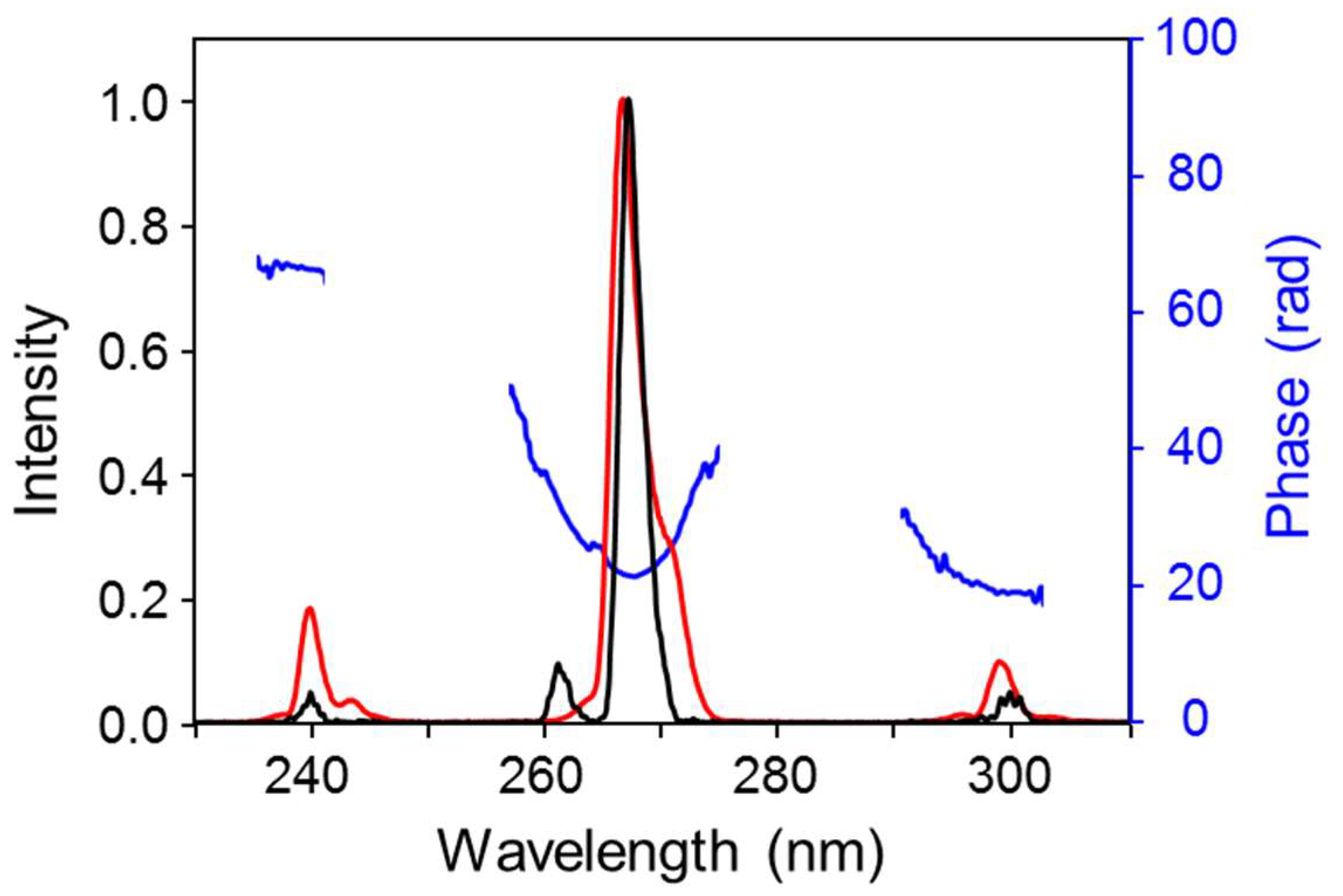
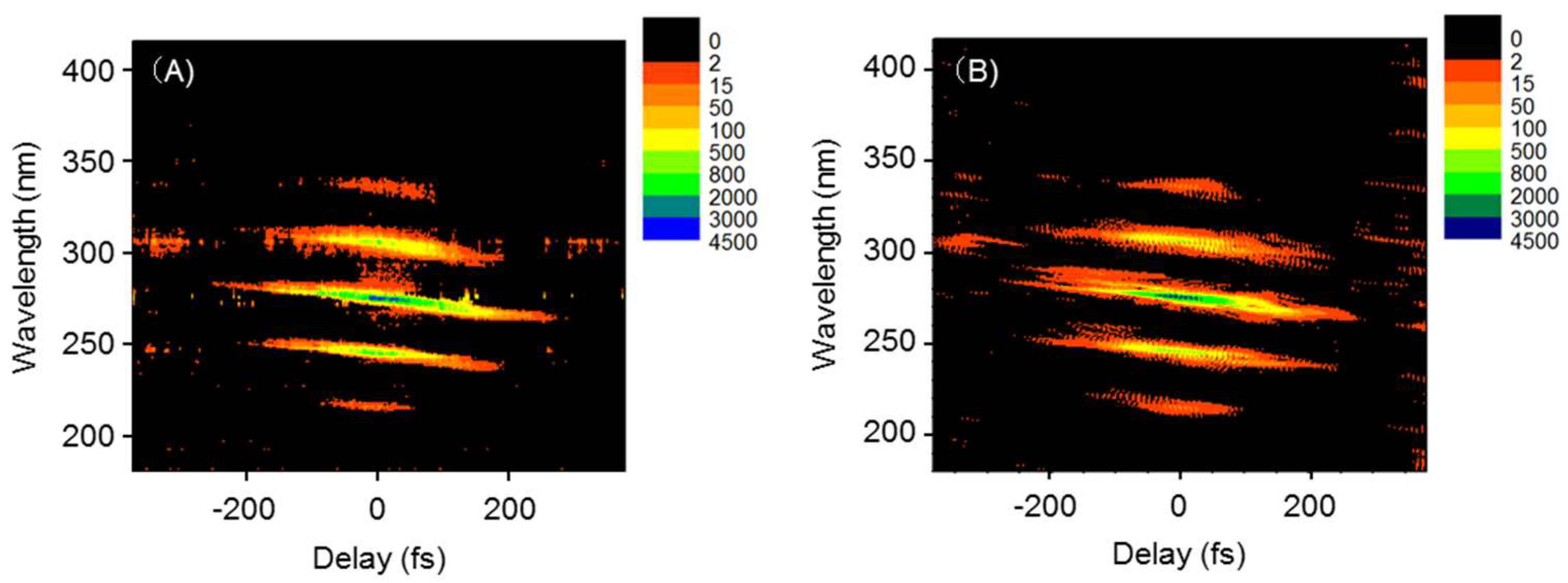


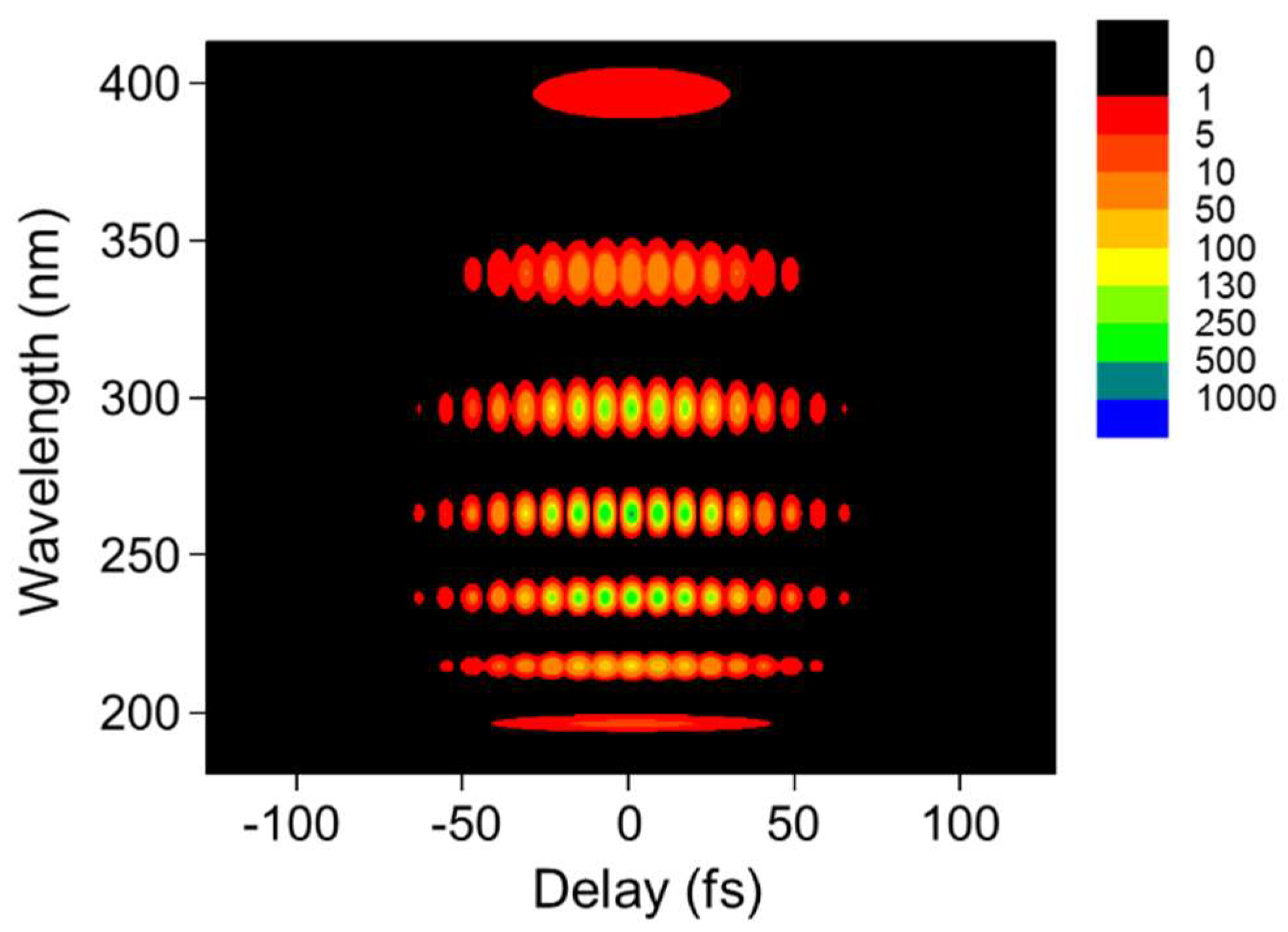
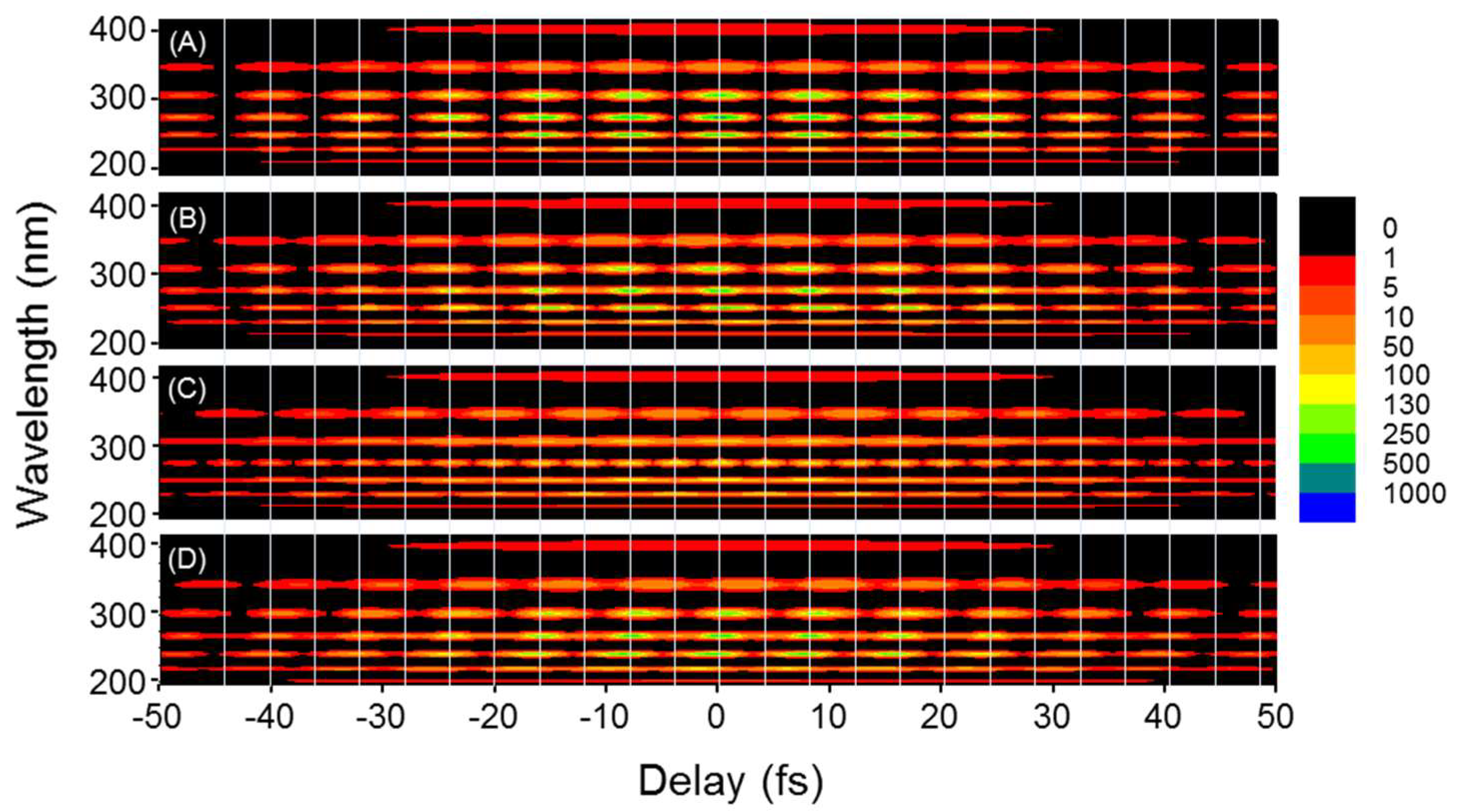


| Component | Origin | Component | Origin |
|---|---|---|---|
| Wavelength (nm) | (Wavelength, nm) | Wavelength (nm) | (Wavelength, nm) |
| 400 | 300 + 300 − 240 | 267 | 267 + 240 − 240 |
| 342 | 300 + 300 − 267 | - | 240 + 300 − 267 |
| - | 300 + 267 − 240 | 240 | 300 + 240 − 300 |
| 300 | 300 + 300 − 300 | - | 267 + 267 − 300 |
| - | 300 + 267 − 267 | - | 267 + 240 − 267 |
| - | 267 + 267 − 240 | - | 240 + 240 − 240 |
| - | 240 + 300 − 240 | 219 | 267 + 240 − 300 |
| 267 | 267 + 300 − 300 | - | 240 + 240 − 267 |
| - | 267 + 267 − 267 | 200 | 240 + 240 − 300 |
© 2018 by the authors. Licensee MDPI, Basel, Switzerland. This article is an open access article distributed under the terms and conditions of the Creative Commons Attribution (CC BY) license (http://creativecommons.org/licenses/by/4.0/).
Share and Cite
Mori, Y.; Imasaka, T. Generation of Ultrashort Optical Pulses in the Deep-Ultraviolet Region Based on Four-Wave Raman Mixing. Appl. Sci. 2018, 8, 784. https://doi.org/10.3390/app8050784
Mori Y, Imasaka T. Generation of Ultrashort Optical Pulses in the Deep-Ultraviolet Region Based on Four-Wave Raman Mixing. Applied Sciences. 2018; 8(5):784. https://doi.org/10.3390/app8050784
Chicago/Turabian StyleMori, Yoshifumi, and Totaro Imasaka. 2018. "Generation of Ultrashort Optical Pulses in the Deep-Ultraviolet Region Based on Four-Wave Raman Mixing" Applied Sciences 8, no. 5: 784. https://doi.org/10.3390/app8050784




